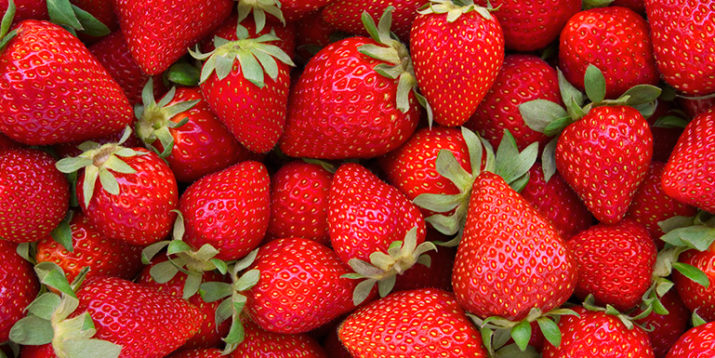Healthy Food Spotlight: Strawberries

Q: What are strawberries?
A: Strawberries are little, red morsels of sweet deliciousness. This is probably why they’re rated the most popular berry in the United States — yeah, no joke. There are more than 200 different varieties grown just in the U.S., and while most varieties are some shade of red, there are white and yellow strawberries, too. Sweet with a hint of tartness, juicy strawberries are packed with vitamin C and other health-boosting antioxidants.
Q: When are strawberries in season?
A: Although you can find them at your local grocery store most months out of the year, spring and summer are when strawberries really shine. Want to make them last all year? Pick up some extra cartons during the peak months and freeze them for the fall and winter months.
Q: How do I choose strawberries?
A: Bigger is better, right? Wrong. At least when it comes to strawberries. Typically, the smaller the berry, the more intense the flavor, while larger, water-filled berries may have a more diluted flavor. Look for plump strawberries that are firm and bright red, without bruises. The caps should be bright green and fully attached. Also, be sure to check the carton for mold.
Q: What are the health benefits of strawberries?
A: We often think of oranges and other citrus as the kings of vitamin C, but one cup of strawberry halves has 149 percent of your daily needs of this important vitamin. They also deserve props for their fiber, manganese, folate, and potassium content too. Strawberries contain several phytonutrients — including phenolic acids — which may have distinct health benefits.
Q: How do I store strawberries?
A: Strawberries are delicate and should be handled with care. Before storing, toss any squished or damaged berries — they can contaminate the rest of the batch. Store unwashed strawberries in the refrigerator until they’re ready to eat, in a single layer if you can. Keep the green caps on until you’re ready to use the berries. They should stay fresh for up to three days.
Q: How do you eat strawberries?
A: Keep it simple and eat them as a snack on their own. Not your jam? (Yeah, we went there.) Go the more sophisticated route and pair strawberries with balsamic vinegar — this combo takes any salad, whole grain, or even dessert to the next level. Make a smoothie like a boss by keeping frozen strawberries on hand — they’ll help thicken it up.
Q: How do I get my kids to like strawberries?
A: This one shouldn’t be too hard — ripe strawberries pretty much taste like candy to begin with! Play up their vibrant red color by hulling and slicing a few strawberries and arranging them on a snack plate with slices of bright green kiwi, a sliced banana, and a handful of blueberries. What kid can say no to a parfait? Make a healthy breakfast parfait by layering Greek yogurt, strawberries, and other fresh fruit.
Nutrition Information
Serving Size: 1 cup, halves (1 Purple Portion-Control Container)
Calories: 49
Total Fat: 0 g
Saturated Fat: 0 g
Monounsaturated Fat: 0 g
Polyunsaturated Fat: 0 g
Cholesterol: 0 mg
Sodium: 2 mg
Total Carbohydrates: 12 g
Dietary Fiber: 3 g
Sugars: 7 g
Protein: 1 g
Vitamin C: 149% DV
Manganese: 29% DV
Folate: 9% DV
Potassium: 7% DV
Magnesium: 5% DV
Copper: 4% DV
